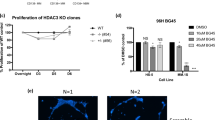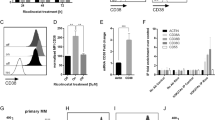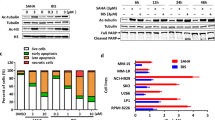Abstract
Multiple myeloma (MM) is a B-cell malignancy, which often remains incurable because of the development of drug resistance governed by the bone marrow (BM) microenvironment. Novel treatment strategies are therefore urgently needed. In this study, we evaluated the anti-MM activity of JNJ-26481585, a novel ‘second-generation’ pyrimidyl-hydroxamic acid-based histone deacetylase inhibitor, using the syngeneic murine 5TMM model of MM. In vitro, JNJ-26481585 induced caspase cascade activation and upregulation of p21, resulting in apoptosis and cell cycle arrest in the myeloma cells at low nanomolar concentrations. Similar results could be observed in BM endothelial cells using higher concentrations, indicating the selectivity of JNJ-26481585 toward cancer cells. In a prophylactic and therapeutic setting, treatment with JNJ-26481585 resulted in an almost complete reduction of the tumor load and a significant decrease in angiogenesis. 5T2MM-bearing mice also developed a MM-related bone disease, characterized by increased osteoclast number, development of osteolytic lesions and a reduction in cancellous bone. Treatment of these mice with JNJ-264815 significantly reduced the development of bone disease. These data suggest that JNJ-26481585 has a potent anti-MM activity that can overcome the stimulatory effect of the BM microenvironment in vivo making this drug a promising new anti-MM agent.
This is a preview of subscription content, access via your institution
Access options
Subscribe to this journal
Receive 12 print issues and online access
$259.00 per year
only $21.58 per issue
Buy this article
- Purchase on Springer Link
- Instant access to full article PDF
Prices may be subject to local taxes which are calculated during checkout





Similar content being viewed by others
References
Sirohi B, Powles R . Multiple myeloma. Lancet 2004; 363: 875–887.
Menu E, Kooijman R, Van Valckenborgh E, Asosingh K, Bakkus M, Van Camp B et al. Specific roles for the PI3 K and the MEK-ERK pathway in IGF-1-stimulated chemotaxis, VEGF secretion and proliferation of multiple myeloma cells: study in the 5T33 MM model. Br J Cancer 2004; 90: 1076–1083.
Vacca A, Ribatti D . Bone marrow angiogenesis in multiple myeloma. Leukemia 2006; 20: 193–199.
Jakob C, Sterz J, Zavrski I, Heider U, Kleeberg L, Fleissner C et al. Angiogenesis in multiple myeloma. Eur J Cancer 2006; 42: 1581–1590.
Giuliani N, Rizzoli V, Roodman GD . Multiple myeloma bone disease: pathophysiology of osteoblast inhibition. Blood 2006; 108: 3992–3996.
Heider U, Fleissner C, Zavrski I, Kaiser M, Hecht M, Jakob C et al. Bone markers in multiple myeloma. Eur J Cancer 2006; 42: 1544–1553.
Choi SJ, Cruz JC, Craig F, Chung H, Devlin RD, Roodman GD et al. Macrophage inflammatory protein 1-alpha is a potential osteoclast stimulatory factor in multiple myeloma. Blood 2000; 96: 671–675.
Tian E, Zhan F, Walker R, Rasmussen E, Ma Y, Barlogie B et al. The role of the Wnt-signaling antagonist DKK1 in the development of osteolytic lesions in multiple myeloma. N Engl J Med 2003; 349: 2483–2494.
Heider U, Hofbauer LC, Zavrski I, Kaiser M, Jakob C, Sezer O . Novel aspects of osteoclast activation and osteoblast inhibition in myeloma bone disease. Biochem Biophys Res Commun 2005; 338: 687–693.
Kumar SK, Rajkumar SV, Dispenzieri A, Lacy MQ, Hayman SR, Buadi FK et al. Improved survival in multiple myeloma and the impact of novel therapies. Blood 2008; 111: 2516–2520.
Attal M, Harousseau JL, Facon T, Guilhot F, Doyen C, Fuzibet JG et al. Single versus double autologous stem-cell transplantation for multiple myeloma. N Engl J Med 2003; 349: 2495–2502.
Richardson PG, Mitsiades C, Schlossman R, Munshi N, Anderson K . New drugs for myeloma. Oncologist 2007; 12: 664–689.
Singhal S, Mehta J . Multiple myeloma. Clin J Am Soc Nephrol 2006; 1: 1322–1330.
Ghobrial J, Ghobrial IM, Mitsiades C, Leleu X, Hatjiharissi E, Moreau AS et al. Novel therapeutic avenues in myeloma: changing the treatment paradigm. Oncology (Williston Park) 2007; 21: 785–792; discussion 798–800.
Bolden JE, Peart MJ, Johnstone RW . Anticancer activities of histone deacetylase inhibitors. Nat Rev Drug Discov 2006; 5: 769–784.
Mottet D, Castronovo V . Histone deacetylases: target enzymes for cancer therapy. Clin Exp Metastasis 2007; 25: 183–189.
Kim MS, Kwon HJ, Lee YM, Baek JH, Jang JE, Lee SW et al. Histone deacetylases induce angiogenesis by negative regulation of tumor suppressor genes. Nat Med 2001; 7: 437–443.
Deroanne CF, Bonjean K, Servotte S, Devy L, Colige A, Clausse N et al. Histone deacetylases inhibitors as anti-angiogenic agents altering vascular endothelial growth factor signaling. Oncogene 2002; 21: 427–436.
Michaelis M, Michaelis UR, Fleming I, Suhan T, Cinatl J, Blaheta RA et al. Valproic acid inhibits angiogenesis in vitro and in vivo. Mol Pharmacol 2004; 65: 520–527.
Qian DZ, Kato Y, Shabbeer S, Wei Y, Verheul HM, Salumbides B et al. Targeting tumor angiogenesis with histone deacetylase inhibitors: the hydroxamic acid derivative LBH589. Clin Cancer Res 2006; 12: 634–642.
Iwami K, Moriyama T . Effects of short chain fatty acid, sodium butyrate, on osteoblastic cells and osteoclastic cells. Int J Biochem 1993; 25: 1631–1635.
de Boer J, Licht R, Bongers M, van der Klundert T, Arends R, van Blitterswijk C . Inhibition of histone acetylation as a tool in bone tissue engineering. Tissue Eng 2006; 12: 2927–2937.
Yi T, Baek JH, Kim HJ, Choi MH, Seo SB, Ryoo HM et al. Trichostatin A-mediated upregulation of p21(WAF1) contributes to osteoclast apoptosis. Exp Mol Med 2007; 39: 213–221.
Chen TH, Chen WM, Hsu KH, Kuo CD, Hung SC . Sodium butyrate activates ERK to regulate differentiation of mesenchymal stem cells. Biochem Biophys Res Commun 2007; 355: 913–918.
Mitsiades N, Mitsiades CS, Richardson PG, McMullan C, Poulaki V, Fanourakis G et al. Molecular sequelae of histone deacetylase inhibition in human malignant B cells. Blood 2003; 101: 4055–4062.
Khan SB, Maududi T, Barton K, Ayers J, Alkan S . Analysis of histone deacetylase inhibitor, depsipeptide (FR901228), effect on multiple myeloma. Br J Haematol 2004; 125: 156–161.
Fandy TE, Shankar S, Ross DD, Sausville E, Srivastava RK . Interactive effects of HDAC inhibitors and TRAIL on apoptosis are associated with changes in mitochondrial functions and expressions of cell cycle regulatory genes in multiple myeloma. Neoplasia 2005; 7: 646–657.
Maiso P, Carvajal-Vergara X, Ocio EM, Lopez-Perez R, Mateo G, Gutierrez N et al. The histone deacetylase inhibitor LBH589 is a potent antimyeloma agent that overcomes drug resistance. Cancer Res 2006; 66: 5781–5789.
Giles F, Fischer T, Cortes J, Garcia-Manero G, Beck J, Ravandi F et al. A phase I study of intravenous LBH589, a novel cinnamic hydroxamic acid analogue histone deacetylase inhibitor, in patients with refractory hematologic malignancies. Clin Cancer Res 2006; 12: 4628–4635.
Gimsing P, Hansen M, Knudsen LM, Knoblauch P, Christensen IJ, Ooi CE et al. A phase I clinical trial of the histone deacetylase inhibitor belinostat in patients with advanced hematological neoplasia. Eur J Haematol 2008; 81: 170–176.
O'Connor OA, Heaney ML, Schwartz L, Richardson S, Willim R, MacGregor-Cortelli B et al. Clinical experience with intravenous and oral formulations of the novel histone deacetylase inhibitor suberoylanilide hydroxamic acid in patients with advanced hematologic malignancies. J Clin Oncol 2006; 24: 166–173.
Radl J, De Glopper ED, Schuit HR, Zurcher C . Idiopathic paraproteinemia. II. Transplantation of the paraprotein-producing clone from old to young C57BL/KaLwRij mice. J Immunol 1979; 122: 609–613.
Vanderkerken K, Asosingh K, Croucher P, Van Camp B . Multiple myeloma biology: lessons from the 5TMM models. Immunol Rev 2003; 194: 196–206.
Asosingh K, Radl J, Van Riet I, Van Camp B, Vanderkerken K . The 5TMM series: a useful in vivo mouse model of human multiple myeloma. Hematol J 2000; 1: 351–356.
Caers J, Asosingh K, Van Riet I, Van Camp B, Vanderkerken K . Of mice and men: disease models of multiple myeloma. Drug Discov Today Dis Models 2004; 1: 373–380.
Arts J, Angibaud P, Marien A, Floren W, Janssens B, King P et al. R306465 is a novel potent inhibitor of class I histone deacetylases with broad-spectrum antitumoral activity against solid and haematological malignancies. Br J Cancer 2007; 97: 1344–1353.
Vanderkerken K, Asosingh K, Willems A, De Raeve H, Couck P, Gorus F et al. The 5T2 MM murine model of multiple myeloma: maintenance and analysis. Methods Mol Med 2005; 113: 191–205.
Van Valckenborgh E, De Raeve H, Devy L, Blacher S, Munaut C, Noel A et al. Murine 5T multiple myeloma cells induce angiogenesis in vitro and in vivo. Br J Cancer 2002; 86: 796–802.
Van Valckenborgh E, Bakkus M, Munaut C, Noel A, St Pierre Y, Asosingh K et al. Upregulation of matrix metalloproteinase-9 in murine 5T33 multiple myeloma cells by interaction with bone marrow endothelial cells. Int J Cancer 2002; 101: 512–518.
Vavrova J, Janovska S, Rezacova M, Hernychova L, Ticha Z, Vokurkova D et al. Proteomic analysis of MOLT-4 cells treated by valproic acid. Mol Cell Biochem 2007; 303: 53–61.
Arts J, Mariën A, King P, Floren W, Beliën A, Janssen L et al. JNJ-26481585—a novel ‘second-generation’ oral Histone Deacetylase inhibitor shows broad-spectrum preclinical antitumoral activity. (submitted 2009).
Catley L, Weisberg E, Tai YT, Atadja P, Remiszewski S, Hideshima T et al. NVP-LAQ824 is a potent novel histone deacetylase inhibitor with significant activity against multiple myeloma. Blood 2003; 102: 2615–2622.
Kaiser M, Zavrski I, Sterz J, Jakob C, Fleissner C, Kloetzel PM et al. The effects of the histone deacetylase inhibitor valproic acid on cell cycle, growth suppression and apoptosis in multiple myeloma. Haematologica 2006; 91: 248–251.
Mitsiades CS, Mitsiades NS, McMullan CJ, Poulaki V, Shringarpure R, Hideshima T et al. Transcriptional signature of histone deacetylase inhibition in multiple myeloma: biological and clinical implications. Proc Natl Acad Sci USA 2004; 101: 540–545.
Neri P, Tagliaferri P, Di Martino MT, Calimeri T, Amodio N, Bulotta A et al. In vivo anti-myeloma activity and modulation of gene expression profile induced by valproic acid, a histone deacetylase inhibitor. Br J Haematol 2008; 143: 520–531.
Hideshima T, Bradner JE, Wong J, Chauhan D, Richardson P, Schreiber SL et al. Small-molecule inhibition of proteasome and aggresome function induces synergistic antitumor activity in multiple myeloma. Proc Natl Acad Sci USA 2005; 102: 8567–8572.
Catley L, Weisberg E, Kiziltepe T, Tai YT, Hideshima T, Neri P et al. Aggresome induction by proteasome inhibitor bortezomib and alpha-tubulin hyperacetylation by tubulin deacetylase (TDAC) inhibitor LBH589 are synergistic in myeloma cells. Blood 2006; 108: 3441–3449.
Nawrocki ST, Carew JS, Maclean KH, Courage JF, Huang P, Houghton JA et al. Myc regulates aggresome formation, the induction of Noxa, and apoptosis in response to the combination of bortezomib and SAHA. Blood 2008; 112: 2917–2926.
Pei XY, Dai Y, Grant S . Synergistic induction of oxidative injury and apoptosis in human multiple myeloma cells by the proteasome inhibitor bortezomib and histone deacetylase inhibitors. Clin Cancer Res 2004; 10: 3839–3852.
Vanderkerken K, Van Camp B, De Greef C, Vande Broek I, Asosingh K, Van Riet I . Homing of the myeloma cell clone. Acta Oncol 2000; 39: 771–776.
Asosingh K, De Raeve H, Menu E, Van Riet I, Van Marck E, Van Camp B et al. Angiogenic switch during 5T2 MM murine myeloma tumorigenesis: role of CD45 heterogeneity. Blood 2004; 103: 3131–3137.
Vanderkerken K, Goes E, De Raeve H, Radl J, Van Camp B . Follow-up of bone lesions in an experimental multiple myeloma mouse model: description of an in vivo technique using radiography dedicated for mammography. Br J Cancer 1996; 73: 1463–1465.
Deleu S FJ, Lukaszuk A, Doktorova T, Tourwé D, Geerts A, Van Camp B et al. Screening of trichostatin analogues based on cellular potency in the 5T33 MM model. Journal of Cancer Molecules 2008; 4: 117–121.
Mehnert JM, Kelly WK . Histone deacetylase inhibitors: biology and mechanism of action. Cancer J 2007; 13: 23–29.
Golay J, Cuppini L, Leoni F, Mico C, Barbui V, Domenghini M et al. The histone deacetylase inhibitor ITF2357 has anti-leukemic activity in vitro and in vivo and inhibits IL-6 and VEGF production by stromal cells. Leukemia 2007; 21: 1892–1900.
Nakamura T, Kukita T, Shobuike T, Nagata K, Wu Z, Ogawa K et al. Inhibition of histone deacetylase suppresses osteoclastogenesis and bone destruction by inducing IFN-beta production. J Immunol 2005; 175: 5809–5816.
Feng R, Oton A, Mapara MY, Anderson G, Belani C, Lentzsch S . The histone deacetylase inhibitor, PXD101, potentiates bortezomib-induced anti-multiple myeloma effect by induction of oxidative stress and DNA damage. Br J Haematol 2007; 139: 385–397.
von Metzler I, Krebbel H, Hecht M, Manz RA, Fleissner C, Mieth M et al. Bortezomib inhibits human osteoclastogenesis. Leukemia 2007; 21: 2025–2034.
Giuliani N, Morandi F, Tagliaferri S, Lazzaretti M, Bonomini S, Crugnola M et al. The proteasome inhibitor bortezomib affects osteoblast differentiation in vitro and in vivo in multiple myeloma patients. Blood 2007; 110: 334–338.
Mukherjee S, Raje N, Schoonmaker JA, Liu JC, Hideshima T, Wein MN et al. Pharmacologic targeting of a stem/progenitor population in vivo is associated with enhanced bone regeneration in mice. J Clin Invest 2008; 118: 491–504.
Terpos E, Sezer O, Croucher P, Dimopoulos MA . Myeloma bone disease and proteasome inhibition therapies. Blood 2007; 110: 1098–1104.
Kwon HJ, Kim MS, Kim MJ, Nakajima H, Kim KW . Histone deacetylase inhibitor FK228 inhibits tumor angiogenesis. Int J Cancer 2002; 97: 290–296.
Zgouras D, Becker U, Loitsch S, Stein J . Modulation of angiogenesis-related protein synthesis by valproic acid. Biochem Biophys Res Commun 2004; 316: 693–697.
Kuljaca S, Liu T, Tee AE, Haber M, Norris MD, Dwarte T et al. Enhancing the anti-angiogenic action of histone deacetylase inhibitors. Mol Cancer 2007; 6: 68.
Qian DZ, Wang X, Kachhap SK, Kato Y, Wei Y, Zhang L et al. The histone deacetylase inhibitor NVP-LAQ824 inhibits angiogenesis and has a greater antitumor effect in combination with the vascular endothelial growth factor receptor tyrosine kinase inhibitor PTK787/ZK222584. Cancer Res 2004; 64: 6626–6634.
Acknowledgements
We thank A Willems and C Seynaeve for expert technical assistance, Professor F Gorus (AZ VUB, Brussels) for serum paraprotein analysis and Dawn Emerson for the bone analysis. The work was financially supported by the Stichting tegen Kanker, the Onderzoeksraad Vrije Universiteit Brussel (OZR-VUB; GOA48), FWO-Vlaanderen and the Leukeamia Research Fund. Eline Menu is a Postdoctoral Fellow and Isabelle Vande Broek is a Senior Clinical Investigator of the Research Foundation Flanders (FWO).
Author information
Authors and Affiliations
Corresponding author
Rights and permissions
About this article
Cite this article
Deleu, S., Lemaire, M., Arts, J. et al. The effects of JNJ-26481585, a novel hydroxamate-based histone deacetylase inhibitor, on the development of multiple myeloma in the 5T2MM and 5T33MM murine models. Leukemia 23, 1894–1903 (2009). https://doi.org/10.1038/leu.2009.121
Received:
Revised:
Accepted:
Published:
Issue Date:
DOI: https://doi.org/10.1038/leu.2009.121
Keywords
This article is cited by
-
Risk of atrial fibrillation in patients with multiple myeloma: what is known and directions for future study
The Egyptian Heart Journal (2024)
-
Epigenetic regulation in hematopoiesis and its implications in the targeted therapy of hematologic malignancies
Signal Transduction and Targeted Therapy (2023)
-
A novel multistage antiplasmodial inhibitor targeting Plasmodium falciparum histone deacetylase 1
Cell Discovery (2020)
-
A high-throughput screening identifies histone deacetylase inhibitors as therapeutic agents against medulloblastoma
Experimental Hematology & Oncology (2019)
-
Halting pro-survival autophagy by TGFβ inhibition in bone marrow fibroblasts overcomes bortezomib resistance in multiple myeloma patients
Leukemia (2016)



